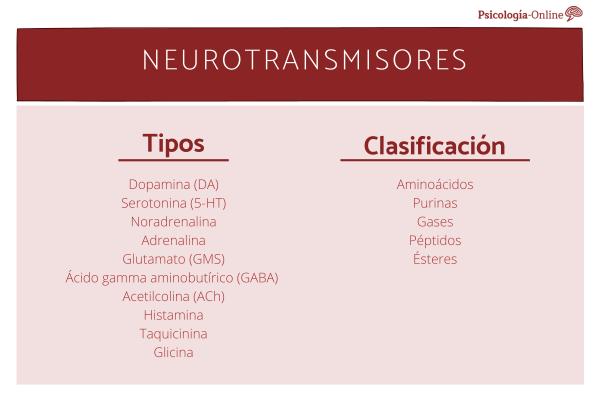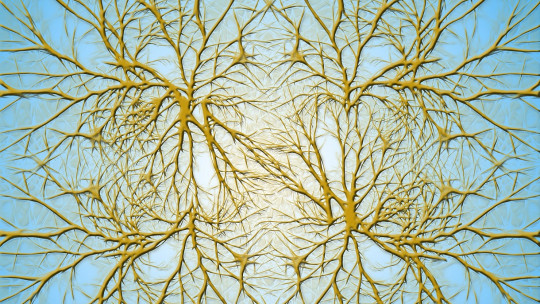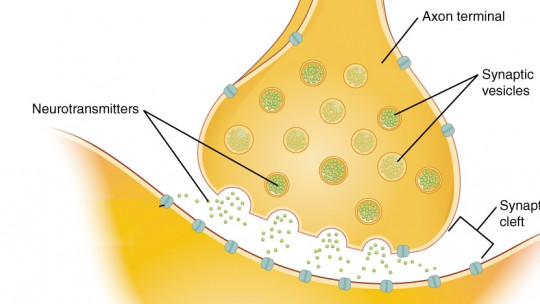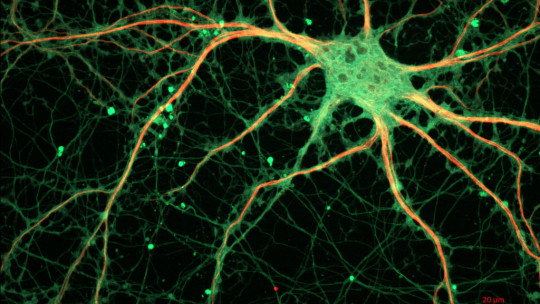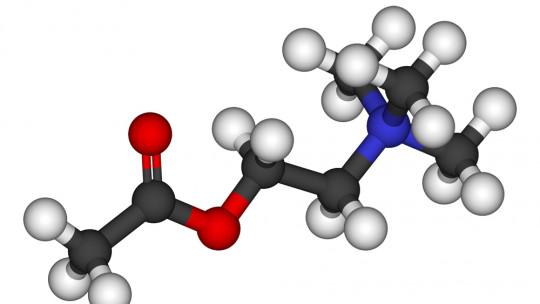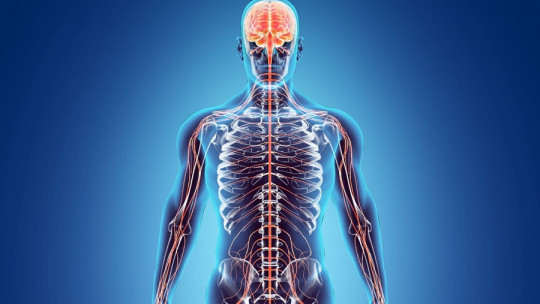Thanks to the functioning of our nervous system, we can be aware of our internal and external world, we can understand and provide meaning to everything that happens to us, what we see, we can learn and carry out what we learn effectively. The nervous system is responsible for coordinating and integrating all the activities of the different systems of our body.
When we talk about what a neurotransmitter is, we are referring to those chemical substances generated by the body that are responsible for emitting signals (information) from one neuron to another through. A process called synapses The neurotransmitter is released through the vesicles through a nervous impulse, then it crosses what is called the presynaptic space to, finally, interact with the postsynaptic neuron, modifying its action potential, producing a specific physiological response.
In this PsychologyFor article, we are going to explain What are neurotransmitters, the types of neurotransmitters and their classification
What are neurotransmitters
Neurotransmitters are biomolecules who are in charge of transmit information from one neuron to another Neurons are linked by a synapse, the intercellular junction that is responsible for the transmission of information between one cell and another through electrical impulses. In the synapse in which the presynaptic neuron is responsible for emitting the information and the postsynaptic neuron is responsible for receiving it.
What are neurotransmitters used for? The functions of neurotransmitters are to inhibit or excite postsynaptic cell activity That is, depending on the type of receptor, neurotransmitters can enhance or decrease its functioning. It is important to mention that the effect that neurotransmitters exert on neurons can be short-term, for a few seconds, or long-term, for months and even years.
The research being carried out on the functions of neurotransmitters is extremely important. The importance of neurotransmitters lies in the fact that thanks to them we can learn more about several of the higher cognitive processes in which they are involved, such as memory, thinking, attention, language, learning, etc.
Types of neurotransmitters
There are more than one hundred types of neurotransmitters, each of them with different functions. In this article, we will focus on describing the main neurotransmitters. If you are wondering what the most important neurotransmitters are, you will find the answer below.
1. Dopamine
Dopamine is one of the most popular types of neurotransmitters, and it is directly related to the feeling of well-being, pleasure and relaxation Dopamine originates in an area of the brain known as the substantia nigra and plays a very important role in the control of our musculoskeletal system, so coordinates movement.
Being also essential for the correct functioning of the central nervous system, it plays a key role in human behavior, which is why it is called neurotransmitter of happiness. Another function of the neurotransmitter is that it produces a depolarizing effect in neurons, creating excellent communication between them, which promotes learning attention and memory.
2. Serotonin
This type of neurotransmitter also plays a role as a hormone. It is located in different sections of the central nervous system and its main function is to regulate the activity of other neurotransmitters.
Serotonin is directly involved in various processes such as digestion, regulation of anxiety and stress levels, body temperature regulation, sleep, appetite, mood and sexual desire
You can see more information in the article What is serotonin and what is it for?
3. Norepinephrine
Norepinephrine is a type of neurotransmitter also known as stress hormone and, like serotonin, it fulfills a double function, that of a neurotransmitter and that of a hormone. Norepinephrine is responsible for activating the sympathetic nervous system and is associated with heart rate and certain processes responsible for attention and generating a response to stress.
4. Adrenaline
Adrenaline is a neurotransmitter that is extremely similar to norepinephrine. Adrenaline is responsible for develop survival mechanisms when we find ourselves in real or even imaginary danger. It also complies with some physiological reactions, such as breathing and blood pressure.
5. Glutamate
Glutamate is the main excitatory neurotransmitter of the central nervous system. Glutamate is related to the neurotransmitter GABA and has a very important role in memory processes and their recovery among other mental processes.
6. Gamma aminobutyric acid (GABA)
Gamma aminobutyric acid (GABA) is a type of neurotransmitter that is responsible for stopping or inhibit the action of some excitatory neurotransmitters The objective of doing so is to prevent us from having certain exaggerated fear and anxiety reactions that only cause us discomfort.
7. Acetylcholine
Acetylcholine is the first neurotransmitter to be discovered. Specifically, acetylcholine is found in different areas of the central nervous system, in the synapses of glands and in muscles. It is responsible for stimulating muscles, activating motor neurons, favors memory and association processes as well as the transition from sleep to wakefulness.
8. Histamine
Histamine is the neurotransmitter responsible for rregulate sleep cycles, control anxiety levels and stress and consolidate memory development. In addition, it also acts as a hormone in the immune system and digestive system. When any part of the body becomes infected, histamine causes inflammatory symptoms as a defense such as skin irritation or sneezing.
9. Tachykinin
Tachykinin is one of the most important neurotransmitters. It is responsible for the maintenance of the autonomic nervous system. Specifically, it regulates involuntary functions such as digestion, breathing or heartbeat In short, tachykinin is responsible for the regulation of all those functions that we do not consciously control, but that are vital for our survival.
10. Wisteria
Glycine as a neurotransmitter allows us to communication between neurons and regulates motor conduction. In addition, glycine is also an amino acid that synthesizes proteins and helps create and regenerate tissues and cell components.
Classification of neurotransmitters
The types of neurotransmitters can be classified as excitatory or inhibitory neurotransmitters. The classification of neurotransmitters can also be done according to their chemical composition and the function they perform.
- Amino acids: These are organic compounds that represent a large number of functions in the body and combine to form proteins. They are basically responsible for maintaining energy and oxygen, which is why they are considered essential for metabolic processing.
- Purines: They are chemical compounds that are mainly responsible for transporting information by acting as chemical messengers.
- Gases: It is one of the most important chemical compounds, since it performs multiple functions such as, for example, it is the largest vasodilator compound in the entire body.
- Peptides: They are a set of amino acids that are distributed throughout the membrane that covers the brain and are responsible for emitting a response to the outside.
- Esters: They are organic compounds derived from petroleum. Within this group of neurotransmitters is acetylcholine, which is an excitatory neurotransmitter. Acetylcholine can sometimes also perform some inhibitory function.
This article is merely informative, at PsychologyFor we do not have the power to make a diagnosis or recommend a treatment. We invite you to go to a psychologist to treat your particular case.
If you want to read more articles similar to What are neurotransmitters we recommend that you enter our Neurosciences category.
Bibliography
- Gomes, T., & Silva, T. (2005). Physiology of the autonomic nervous system (ANS). Hospital del Mar–Esperanza. Available at: http://www.scartd.org/arxius/fisio_sna05.pdf
- Martinez, C. M. (2018). Types of Neurotransmitters: When the chemistry doesn’t let you feel good. Retrieved December 26, 2018, from https://blog.cognifit.com/es/tipos-de-neurotransmisores/
- Classification of Neurotransmitters. (2018). Retrieved December 26, 2018, from https://www.clasificacionde.org/clasificacion-de-neurotransmisores/

